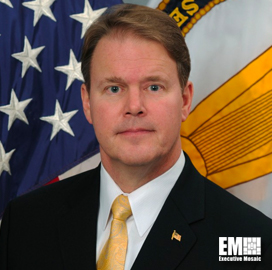William Nelson, director of Assured Position, Navigation and Timing (APNT) Cross Functional Team (CFT) at the U.S. Army, delivered the opening keynote address during Potomac Officers Club’s Ensuring PNT Superiority on the Future Battlefield Virtual Event on November 5th.
If you missed the live version of Ensuring PNT Superiority on the Future Battlefield, you can still access the OnDemand Event by visiting Potomac Officers Club’s Event Archive.
As the CFT director, Nelson is responsible for synchronizing PNT, navigation warfare, and Army Space capability development efforts across the U.S. Army to narrow capability gaps through experimentation and technical demonstrations to inform, develop and rapidly transition capability requirements to the Army Acquisition system.

Lincoln Hudson, senior vice president with Booz Allen Hamilton, introduced Nelson, noting his accomplishments in the defense and federal landscape. Nelson began his address by discussing the role of the CFT.
“CFT is requirements focused. We are tasked to accelerate the delivery of requirements that are informed with continuous experimentation, prototyping and most importantly, soldier feedback. We work within three signature efforts: Assured Position, Navigation and Timing; Tactical Space; and Navigational Warfare (NAVWAR),” Nelson stated.
These environments support soldiers in a GPS environment. Advisories have employed new tactics that have been designed to deny the U.S. use of the electrokinetic spectrum and limit freedom of maneuver to limit the nation’s ability to compete in ground combat. Soldiers are operating in an environment where GPS and PNT are information challenged.
APNT CFT has worked to develop new concepts and tools that help soldiers navigate the evolving landscape. Nelson and his team have worked with program executive offices (PEO) and centers of excellence (CoE) to streamline operations.
Additionally, he has worked with alternative technologies to ensure resilient and survivable PNT and delivering solutions to soldiers. Nelson’s unit has also improved solutions to match the operations environment.
“We’re working on developing alternative PNT solutions that directly align with recent presidential executive order on PNT and support the National Defense Authorization Act (NDAA) guidance. The Army is working with partners to develop a Joint All Domain Command and Control (JADC2),” Nelson said.

Commanding Officer
Army Futures Command
Nelson added that the U.S. Army has recently co-signed with the U.S. Air Force to help develop the JADC2 capability, which will compliment the Army’s multi-domain strategy. In 2018, Gen. Mike Murray, a 2020 Wash100 Award recipient, signed a policy to develop the MAPS program.
“In late 2019, we fielded and equipped the first generation of MAPS. To move from concept to the field it took a total of 18 months, which is truly remarkable. The MAPS OTA will help produce and mature the system to MAPS Gen 2 solution, which includes platform combat integrations,” Nelson said.
With the Army Open Suite of Standards, the defense sector will have access to a “plug and play” system that allows quick and efficient capability installment onto a common platform. “We have PNT cards in development that will integrate anti-jamming capabilities as well. That testing is ongoing, but it will be a big win for the PNT community at large,” Nelson noted.
Within dismounded capabilities, Nelson stated that there is a sister program named Dismounted Distributed PNT Systems (DAPS). Additionally, the PNT Modernization Office will develop solutions in an open systems architecture, as well as an Open Innovations Lab (OIL). OIL will foster partnerships to collaborate on PNT solutions.
APNT CFT has also worked to develop vision based navigation systems, which will be completely independent of GPS constellations. The U.S. Army will work to integrate these systems across defense platforms.
Additionally, the CFT has issued a new sensor to shooter campaign, which has leveraged space and ground technologies to enhance soldier access to targeting. Within the tactical space realm, we have worked to deliver space based capabilities to provide desensing, which provides prompt, accurate and persistent data.
“Will will continue to work with academia and industry as we further advance soldier systems and platforms. We will continue our campaigns and we will see a great benefit in efficiency as we continue those relationships. As we look toward 2035, our CFT is laser focused on that future. We’re emphasizing AI technologies and working with partners to ensure relevant policies,” Nelson concluded.
Following Nelson’s keynote address, Hudson shifted to questions from the audience. Nelson provided further insight into the solutions and goals of the CFT, then an expert panel took the stage to address how DoD and the private sector can work together to create resiliency within the military’s existing GPS enterprise.

The panel featured William Bollwerk, former Department of Defense (DoD) leader, Hironori Sasaki of Orolia Defense & Security and John Betz, a Mitre Fellow Emeritus. The panelists’ discussion was moderated by Hudson.
If you missed the live version of Ensuring PNT Superiority on the Future Battlefield, you can still access the OnDemand Event by visiting Potomac Officers Club’s Event Archive.






